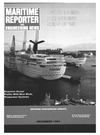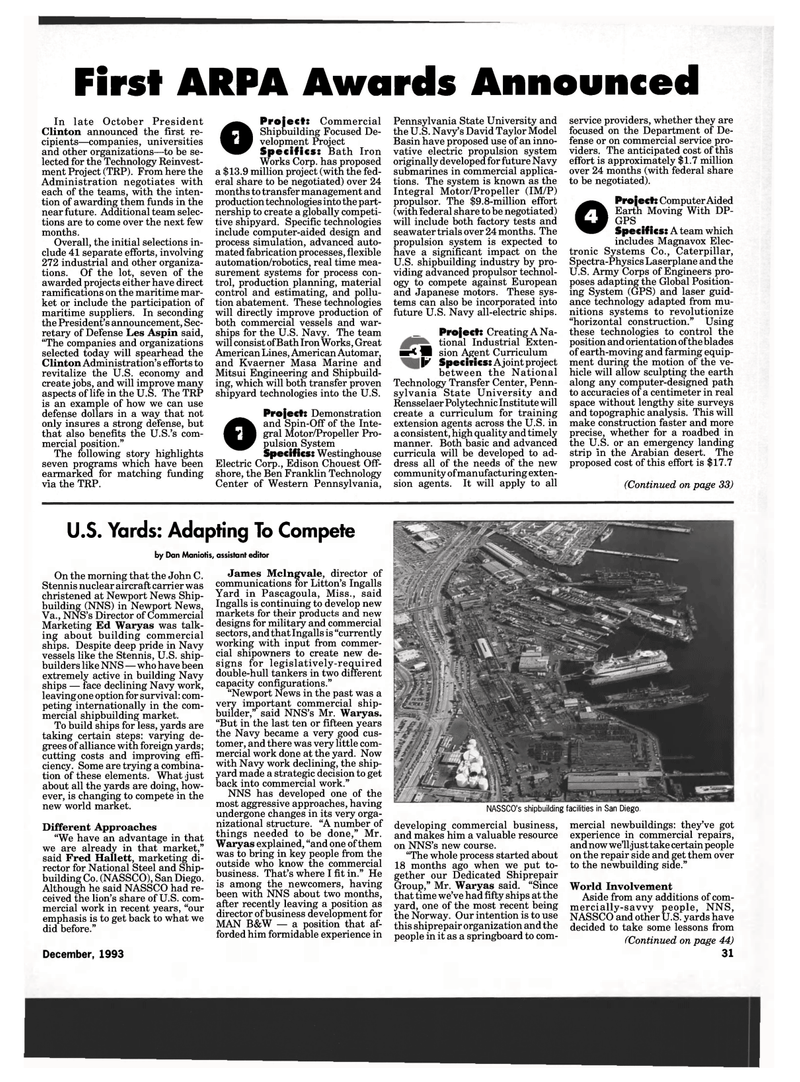
Page 29: of Maritime Reporter Magazine (December 1993)
Read this page in Pdf, Flash or Html5 edition of December 1993 Maritime Reporter Magazine
First ARPA Awards Announced
In late October President
Clinton announced the first re- cipients—companies, universities and other organizations—to be se- lected for the Technology Reinvest- ment Project (TRP). From here the
Administration negotiates with each of the teams, with the inten- tion of awarding them funds in the near future. Additional team selec- tions are to come over the next few months.
Overall, the initial selections in- clude 41 separate efforts, involving 272 industrial and other organiza- tions. Of the lot, seven of the awarded projects either have direct ramifications on the maritime mar- ket or include the participation of maritime suppliers. In seconding the President's announcement, Sec- retary of Defense Les Aspin said, "The companies and organizations selected today will spearhead the
Clinton Administration's efforts to revitalize the U.S. economy and create jobs, and will improve many aspects of life in the U.S. The TRP is an example of how we can use defense dollars in a way that not only insures a strong defense, but that also benefits the U.S.'s com- mercial position."
The following story highlights seven programs which have been earmarked for matching funding via the TRP.
O Project: Commercial Shipbuilding Focused De-velopment Project Specifics: Bath Iron
Works Corp. has proposed a $13.9 million project (with the fed- eral share to be negotiated) over 24 months to transfer management and production technologies into the part- nership to create a globally competi- tive shipyard. Specific technologies include computer-aided design and process simulation, advanced auto- mated fabrication processes, flexible automation/robotics, real time mea- surement systems for process con- trol, production planning, material control and estimating, and pollu- tion abatement. These technologies will directly improve production of both commercial vessels and war- ships for the U.S. Navy. The team will consist of Bath Iron Works, Great
American Lines, American Automar, and Kvaerner Masa Marine and
Mitsui Engineering and Shipbuild- ing, which will both transfer proven shipyard technologies into the U.S.
Project: Demonstration O and Spin-Off of the Inte- gral Motor/Propeller Pro- pulsion System
Specifics: Westinghouse
Electric Corp., Edison Chouest Off- shore, the Ben Franklin Technology
Center of Western Pennsylvania,
Pennsylvania State University and the U.S. Navy's David Taylor Model
Basin have proposed use of an inno- vative electric propulsion system originally developed for future Navy submarines in commercial applica- tions. The system is known as the
Integral Motor/Propeller (IM/P) propulsor. The $9.8-million effort (with federal share to be negotiated) will include both factory tests and seawater trials over 24 months. The propulsion system is expected to have a significant impact on the
U.S. shipbuilding industry by pro- viding advanced propulsor technol- ogy to compete against European and Japanese motors. These sys- tems can also be incorporated into future U.S. Navy all-electric ships. _ Project: Creating A Na- tional Industrial Exten- v^S sion Agent Curriculum
Jp Specifics: Ajoint project between the National
Technology Transfer Center, Penn- sylvania State University and
Rensselaer Polytechnic Institute will create a curriculum for training extension agents across the U.S. in a consistent, high quality and timely manner. Both basic and advanced curricula will be developed to ad- dress all of the needs of the new community of manufacturing exten- sion agents. It will apply to all service providers, whether they are focused on the Department of De- fense or on commercial service pro- viders. The anticipated cost of this effort is approximately $1.7 million over 24 months (with federal share to be negotiated). ©Project: Computer Aided Earth Moving With DP-GPS Specifics: A team which includes Magnavox Elec- tronic Systems Co., Caterpillar,
Spectra-Physics Laserplane and the
U.S. Army Corps of Engineers pro- poses adapting the Global Position- ing System (GPS) and laser guid- ance technology adapted from mu- nitions systems to revolutionize "horizontal construction." Using these technologies to control the position and orientation of the blades of earth-moving and farming equip- ment during the motion of the ve- hicle will allow sculpting the earth along any computer-designed path to accuracies of a centimeter in real space without lengthy site surveys and topographic analysis. This will make construction faster and more precise, whether for a roadbed in the U.S. or an emergency landing strip in the Arabian desert. The proposed cost of this effort is $17.7 (Continued on page 33)
U.S. Yards: Adapting To Compete by Dan Maniotis, assistant editor
On the morning that the John C.
Stennis nuclear aircraft carrier was christened at Newport News Ship- building (NNS) in Newport News,
Va., NNS's Director of Commercial
Marketing Ed Waryas was talk- ing about building commercial ships. Despite deep pride in Navy vessels like the Stennis, U.S. ship- builders like NNS — who have been extremely active in building Navy ships — face declining Navy work, leaving one option for survival: com- peting internationally in the com- mercial shipbuilding market.
To build ships for less, yards are taking certain steps: varying de- grees of alliance with foreign yards; cutting costs and improving effi- ciency. Some are trying a combina- tion of these elements. What just about all the yards are doing, how- ever, is changing to compete in the new world market.
Different Approaches "We have an advantage in that we are already in that market," said Fred Hallett, marketing di- rector for National Steel and Ship- building Co. (NASSCO), San Diego.
Although he said NASSCO had re- ceived the lion's share of U.S. com- mercial work in recent years, "our emphasis is to get back to what we did before."
December, 1993 31
James Mclngvale, director of communications for Litton's Ingalls
Yard in Pascagoula, Miss., said
Ingalls is continuing to develop new markets for their products and new designs for military and commercial sectors, and that Ingalls is "currently working with input from commer- cial shipowners to create new de- signs for legislatively-required double-hull tankers in two different capacity configurations." "Newport News in the past was a very important commercial ship- builder," said NNS's Mr. Waryas. "But in the last ten or fifteen years the Navy became a very good cus- tomer, and there was very little com- mercial work done at the yard. Now with Navy work declining, the ship- yard made a strategic decision to get back into commercial work."
NNS has developed one of the most aggressive approaches, having undergone changes in its very orga- nizational structure. "A number of things needed to be done," Mr.
Waryas explained, "and one of them was to bring in key people from the outside who know the commercial business. That's where I fit in." He is among the newcomers, having been with NNS about two months, after recently leaving a position as director of business development for
MAN B&W — a position that af- forded him formidable experience in developing commercial business, and makes him a valuable resource on NNS's new course. "The whole process started about 18 months ago when we put to- gether our Dedicated Shiprepair
Group," Mr. Waryas said. "Since that time we've had fifty ships at the yard, one of the most recent being the Norway. Our intention is to use this shiprepair organization and the people in it as a springboard to com- mercial newbuildings: they've got experience in commercial repairs, and now we'll just take certain people on the repair side and get them over to the newbuilding side."
World Involvement
Aside from any additions of com- mercially-savvy people, NNS,
NASSCO and other U.S. yards have decided to take some lessons from (Continued on page 44) 31
NASSCO's shipbuilding facilities in San Diego,

 28
28

 30
30
